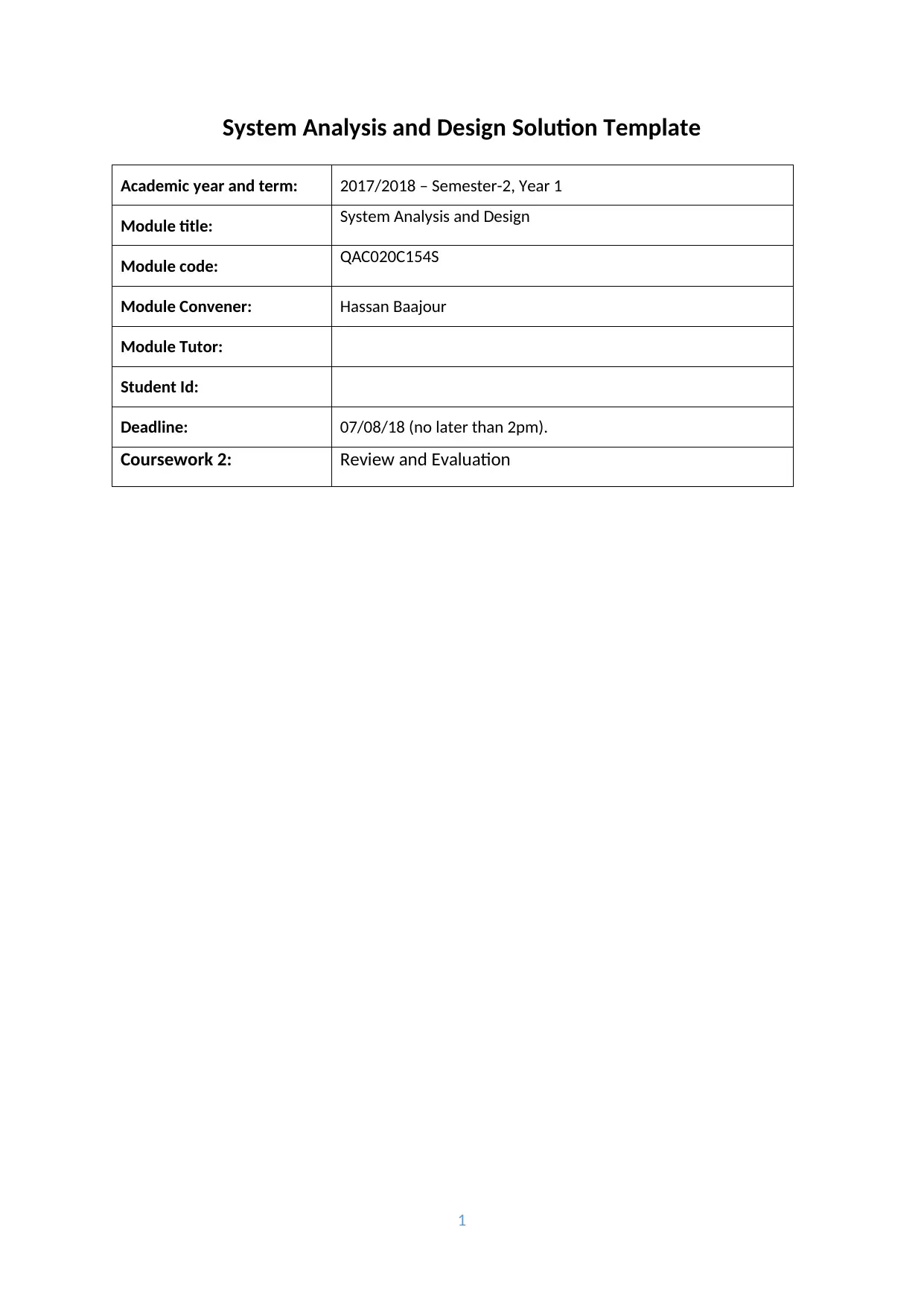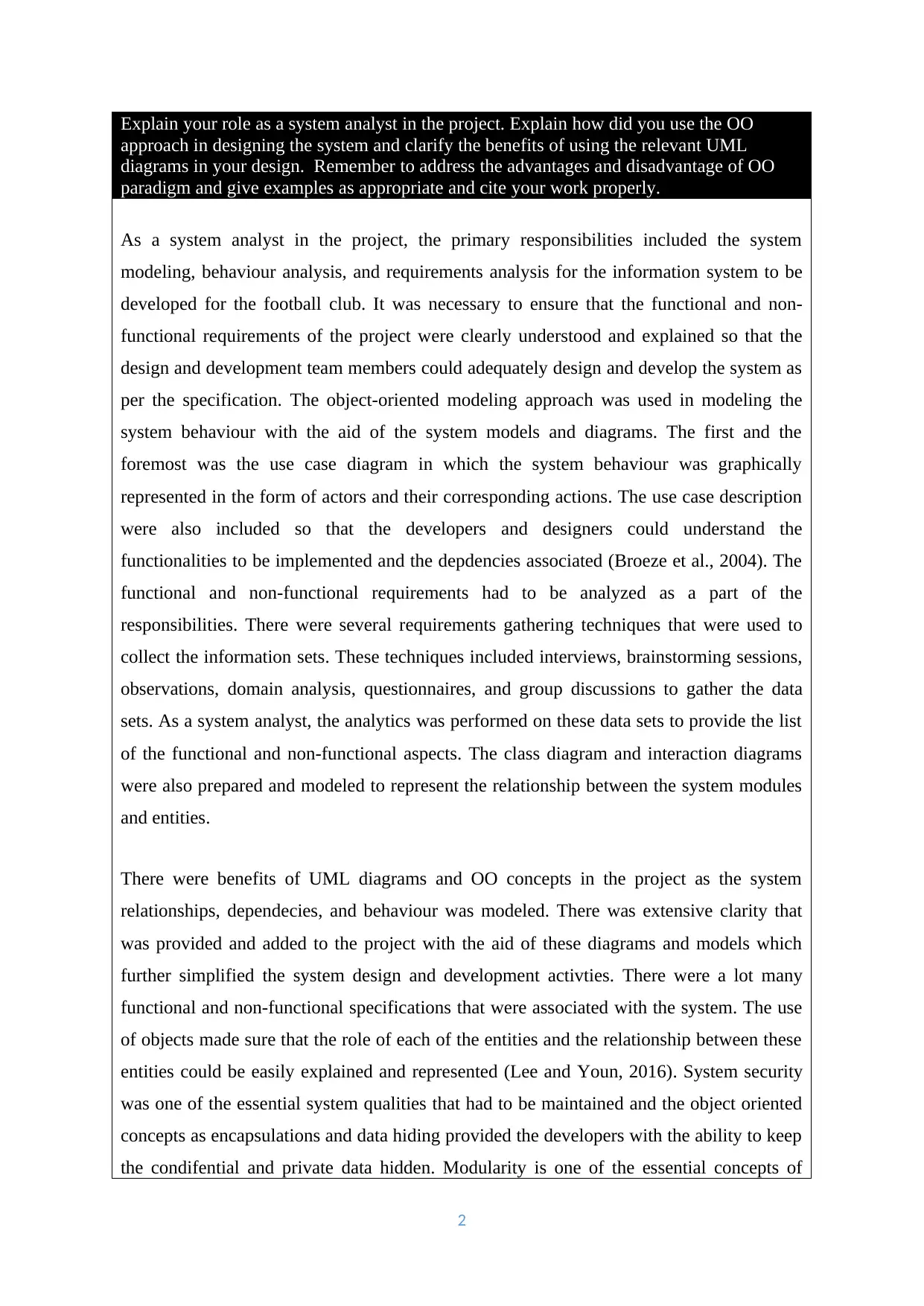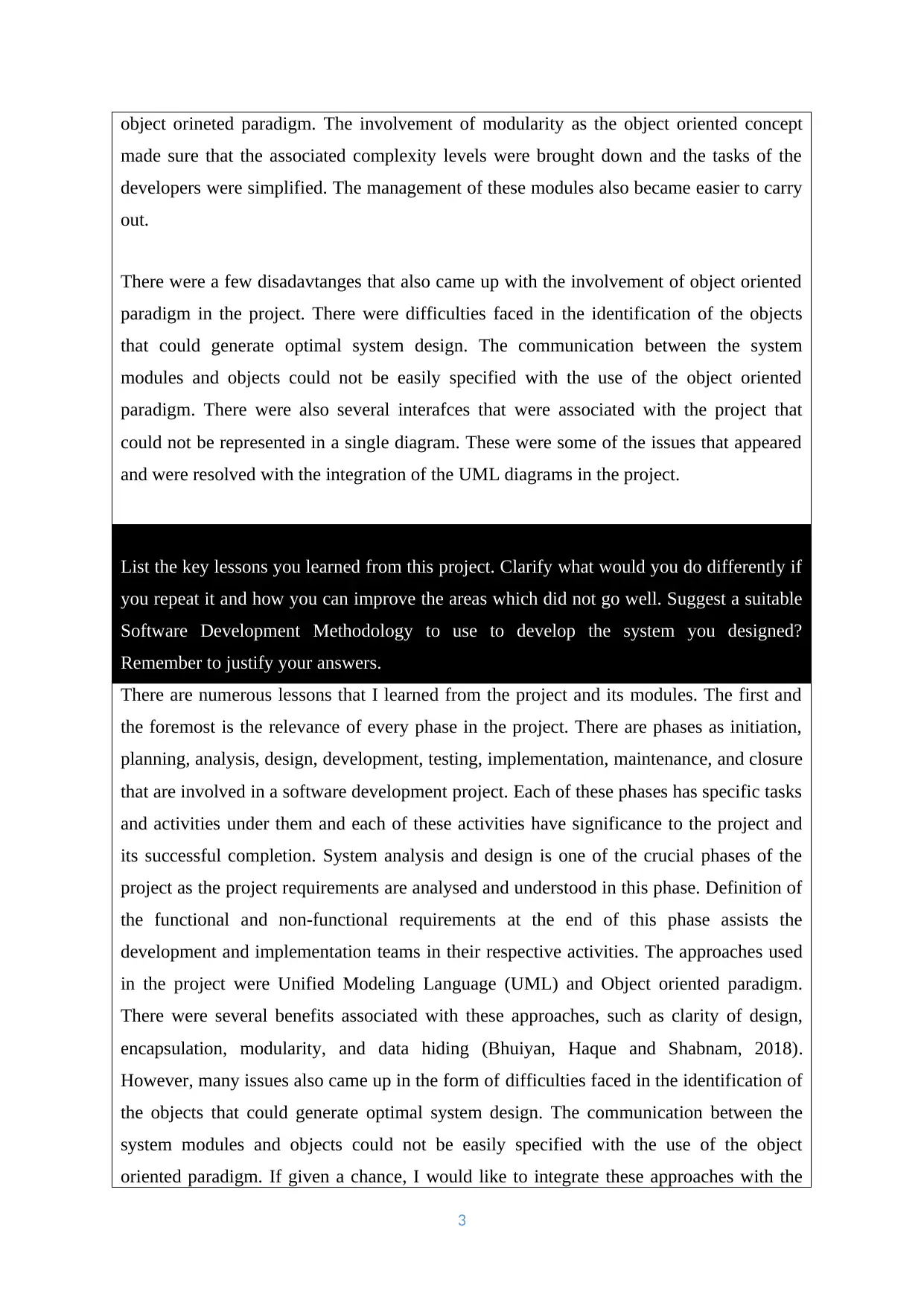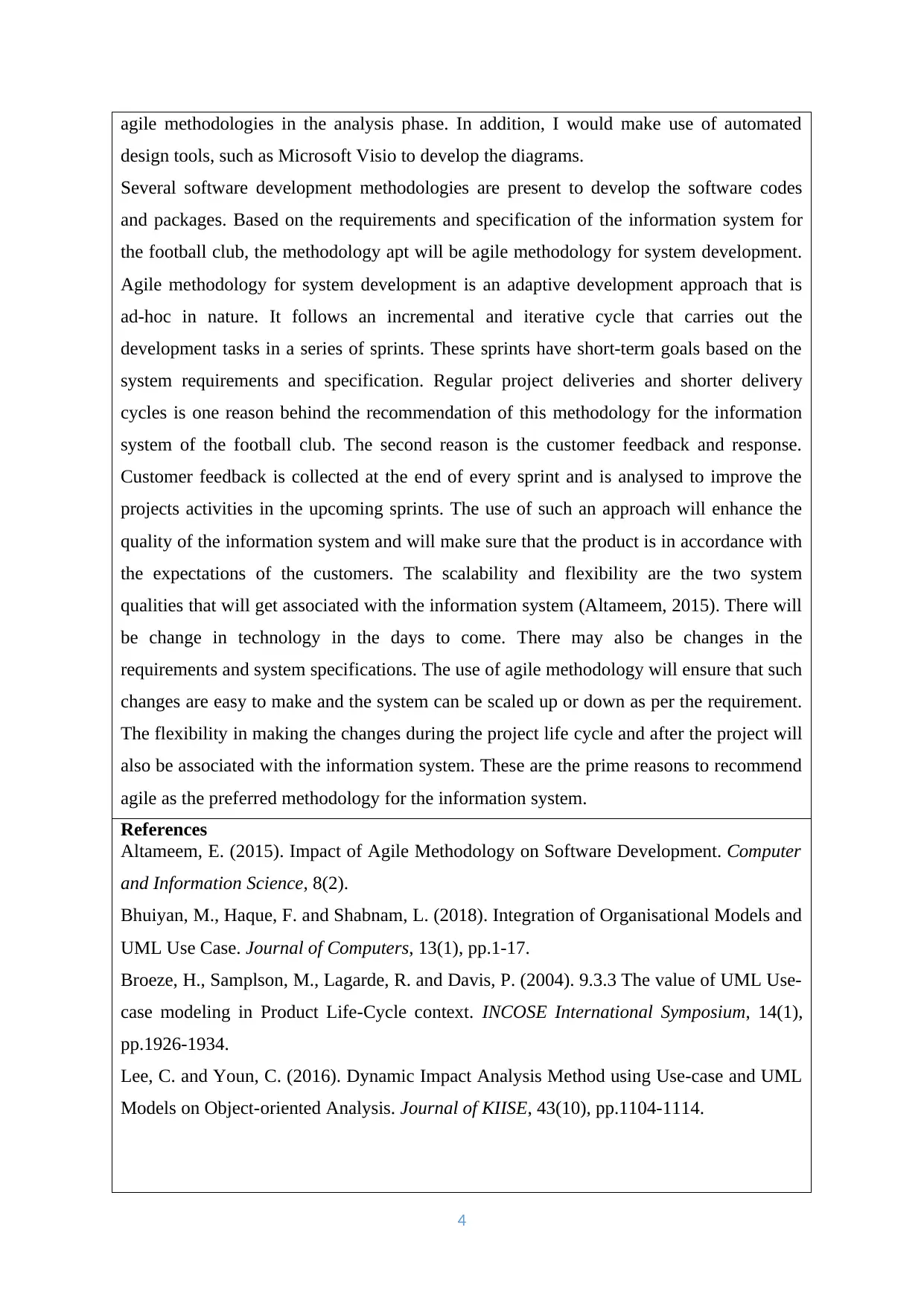System Analysis & Design: Reviewing Object-Oriented Approach & UML
VerifiedAdded on 2023/05/30
|5
|1430
|55
Report
AI Summary
This report provides a review and evaluation of system analysis and design, focusing on the application of the object-oriented (OO) approach and the use of UML diagrams in a football club information system project. As a system analyst, the role involved system modeling, behavior analysis, and requirements analysis. The report discusses the benefits and disadvantages of the OO paradigm, including modularity, encapsulation, and challenges in object identification and communication. Key lessons learned from the project emphasize the importance of each phase in software development and the advantages of UML and OO concepts. The report suggests integrating agile methodologies and automated design tools for improvement and recommends agile methodology for system development due to its adaptive nature, customer feedback integration, scalability, and flexibility.

System Analysis and Design Solution Template
Academic year and term: 2017/2018 – Semester-2, Year 1
Module title: System Analysis and Design
Module code: QAC020C154S
Module Convener: Hassan Baajour
Module Tutor:
Student Id:
Deadline: 07/08/18 (no later than 2pm).
Coursework 2: Review and Evaluation
1
Academic year and term: 2017/2018 – Semester-2, Year 1
Module title: System Analysis and Design
Module code: QAC020C154S
Module Convener: Hassan Baajour
Module Tutor:
Student Id:
Deadline: 07/08/18 (no later than 2pm).
Coursework 2: Review and Evaluation
1
Paraphrase This Document
Need a fresh take? Get an instant paraphrase of this document with our AI Paraphraser

Explain your role as a system analyst in the project. Explain how did you use the OO
approach in designing the system and clarify the benefits of using the relevant UML
diagrams in your design. Remember to address the advantages and disadvantage of OO
paradigm and give examples as appropriate and cite your work properly.
As a system analyst in the project, the primary responsibilities included the system
modeling, behaviour analysis, and requirements analysis for the information system to be
developed for the football club. It was necessary to ensure that the functional and non-
functional requirements of the project were clearly understood and explained so that the
design and development team members could adequately design and develop the system as
per the specification. The object-oriented modeling approach was used in modeling the
system behaviour with the aid of the system models and diagrams. The first and the
foremost was the use case diagram in which the system behaviour was graphically
represented in the form of actors and their corresponding actions. The use case description
were also included so that the developers and designers could understand the
functionalities to be implemented and the depdencies associated (Broeze et al., 2004). The
functional and non-functional requirements had to be analyzed as a part of the
responsibilities. There were several requirements gathering techniques that were used to
collect the information sets. These techniques included interviews, brainstorming sessions,
observations, domain analysis, questionnaires, and group discussions to gather the data
sets. As a system analyst, the analytics was performed on these data sets to provide the list
of the functional and non-functional aspects. The class diagram and interaction diagrams
were also prepared and modeled to represent the relationship between the system modules
and entities.
There were benefits of UML diagrams and OO concepts in the project as the system
relationships, dependecies, and behaviour was modeled. There was extensive clarity that
was provided and added to the project with the aid of these diagrams and models which
further simplified the system design and development activties. There were a lot many
functional and non-functional specifications that were associated with the system. The use
of objects made sure that the role of each of the entities and the relationship between these
entities could be easily explained and represented (Lee and Youn, 2016). System security
was one of the essential system qualities that had to be maintained and the object oriented
concepts as encapsulations and data hiding provided the developers with the ability to keep
the condifential and private data hidden. Modularity is one of the essential concepts of
2
approach in designing the system and clarify the benefits of using the relevant UML
diagrams in your design. Remember to address the advantages and disadvantage of OO
paradigm and give examples as appropriate and cite your work properly.
As a system analyst in the project, the primary responsibilities included the system
modeling, behaviour analysis, and requirements analysis for the information system to be
developed for the football club. It was necessary to ensure that the functional and non-
functional requirements of the project were clearly understood and explained so that the
design and development team members could adequately design and develop the system as
per the specification. The object-oriented modeling approach was used in modeling the
system behaviour with the aid of the system models and diagrams. The first and the
foremost was the use case diagram in which the system behaviour was graphically
represented in the form of actors and their corresponding actions. The use case description
were also included so that the developers and designers could understand the
functionalities to be implemented and the depdencies associated (Broeze et al., 2004). The
functional and non-functional requirements had to be analyzed as a part of the
responsibilities. There were several requirements gathering techniques that were used to
collect the information sets. These techniques included interviews, brainstorming sessions,
observations, domain analysis, questionnaires, and group discussions to gather the data
sets. As a system analyst, the analytics was performed on these data sets to provide the list
of the functional and non-functional aspects. The class diagram and interaction diagrams
were also prepared and modeled to represent the relationship between the system modules
and entities.
There were benefits of UML diagrams and OO concepts in the project as the system
relationships, dependecies, and behaviour was modeled. There was extensive clarity that
was provided and added to the project with the aid of these diagrams and models which
further simplified the system design and development activties. There were a lot many
functional and non-functional specifications that were associated with the system. The use
of objects made sure that the role of each of the entities and the relationship between these
entities could be easily explained and represented (Lee and Youn, 2016). System security
was one of the essential system qualities that had to be maintained and the object oriented
concepts as encapsulations and data hiding provided the developers with the ability to keep
the condifential and private data hidden. Modularity is one of the essential concepts of
2

object orineted paradigm. The involvement of modularity as the object oriented concept
made sure that the associated complexity levels were brought down and the tasks of the
developers were simplified. The management of these modules also became easier to carry
out.
There were a few disadavtanges that also came up with the involvement of object oriented
paradigm in the project. There were difficulties faced in the identification of the objects
that could generate optimal system design. The communication between the system
modules and objects could not be easily specified with the use of the object oriented
paradigm. There were also several interafces that were associated with the project that
could not be represented in a single diagram. These were some of the issues that appeared
and were resolved with the integration of the UML diagrams in the project.
List the key lessons you learned from this project. Clarify what would you do differently if
you repeat it and how you can improve the areas which did not go well. Suggest a suitable
Software Development Methodology to use to develop the system you designed?
Remember to justify your answers.
There are numerous lessons that I learned from the project and its modules. The first and
the foremost is the relevance of every phase in the project. There are phases as initiation,
planning, analysis, design, development, testing, implementation, maintenance, and closure
that are involved in a software development project. Each of these phases has specific tasks
and activities under them and each of these activities have significance to the project and
its successful completion. System analysis and design is one of the crucial phases of the
project as the project requirements are analysed and understood in this phase. Definition of
the functional and non-functional requirements at the end of this phase assists the
development and implementation teams in their respective activities. The approaches used
in the project were Unified Modeling Language (UML) and Object oriented paradigm.
There were several benefits associated with these approaches, such as clarity of design,
encapsulation, modularity, and data hiding (Bhuiyan, Haque and Shabnam, 2018).
However, many issues also came up in the form of difficulties faced in the identification of
the objects that could generate optimal system design. The communication between the
system modules and objects could not be easily specified with the use of the object
oriented paradigm. If given a chance, I would like to integrate these approaches with the
3
made sure that the associated complexity levels were brought down and the tasks of the
developers were simplified. The management of these modules also became easier to carry
out.
There were a few disadavtanges that also came up with the involvement of object oriented
paradigm in the project. There were difficulties faced in the identification of the objects
that could generate optimal system design. The communication between the system
modules and objects could not be easily specified with the use of the object oriented
paradigm. There were also several interafces that were associated with the project that
could not be represented in a single diagram. These were some of the issues that appeared
and were resolved with the integration of the UML diagrams in the project.
List the key lessons you learned from this project. Clarify what would you do differently if
you repeat it and how you can improve the areas which did not go well. Suggest a suitable
Software Development Methodology to use to develop the system you designed?
Remember to justify your answers.
There are numerous lessons that I learned from the project and its modules. The first and
the foremost is the relevance of every phase in the project. There are phases as initiation,
planning, analysis, design, development, testing, implementation, maintenance, and closure
that are involved in a software development project. Each of these phases has specific tasks
and activities under them and each of these activities have significance to the project and
its successful completion. System analysis and design is one of the crucial phases of the
project as the project requirements are analysed and understood in this phase. Definition of
the functional and non-functional requirements at the end of this phase assists the
development and implementation teams in their respective activities. The approaches used
in the project were Unified Modeling Language (UML) and Object oriented paradigm.
There were several benefits associated with these approaches, such as clarity of design,
encapsulation, modularity, and data hiding (Bhuiyan, Haque and Shabnam, 2018).
However, many issues also came up in the form of difficulties faced in the identification of
the objects that could generate optimal system design. The communication between the
system modules and objects could not be easily specified with the use of the object
oriented paradigm. If given a chance, I would like to integrate these approaches with the
3
⊘ This is a preview!⊘
Do you want full access?
Subscribe today to unlock all pages.

Trusted by 1+ million students worldwide

agile methodologies in the analysis phase. In addition, I would make use of automated
design tools, such as Microsoft Visio to develop the diagrams.
Several software development methodologies are present to develop the software codes
and packages. Based on the requirements and specification of the information system for
the football club, the methodology apt will be agile methodology for system development.
Agile methodology for system development is an adaptive development approach that is
ad-hoc in nature. It follows an incremental and iterative cycle that carries out the
development tasks in a series of sprints. These sprints have short-term goals based on the
system requirements and specification. Regular project deliveries and shorter delivery
cycles is one reason behind the recommendation of this methodology for the information
system of the football club. The second reason is the customer feedback and response.
Customer feedback is collected at the end of every sprint and is analysed to improve the
projects activities in the upcoming sprints. The use of such an approach will enhance the
quality of the information system and will make sure that the product is in accordance with
the expectations of the customers. The scalability and flexibility are the two system
qualities that will get associated with the information system (Altameem, 2015). There will
be change in technology in the days to come. There may also be changes in the
requirements and system specifications. The use of agile methodology will ensure that such
changes are easy to make and the system can be scaled up or down as per the requirement.
The flexibility in making the changes during the project life cycle and after the project will
also be associated with the information system. These are the prime reasons to recommend
agile as the preferred methodology for the information system.
References
Altameem, E. (2015). Impact of Agile Methodology on Software Development. Computer
and Information Science, 8(2).
Bhuiyan, M., Haque, F. and Shabnam, L. (2018). Integration of Organisational Models and
UML Use Case. Journal of Computers, 13(1), pp.1-17.
Broeze, H., Samplson, M., Lagarde, R. and Davis, P. (2004). 9.3.3 The value of UML Use-
case modeling in Product Life-Cycle context. INCOSE International Symposium, 14(1),
pp.1926-1934.
Lee, C. and Youn, C. (2016). Dynamic Impact Analysis Method using Use-case and UML
Models on Object-oriented Analysis. Journal of KIISE, 43(10), pp.1104-1114.
4
design tools, such as Microsoft Visio to develop the diagrams.
Several software development methodologies are present to develop the software codes
and packages. Based on the requirements and specification of the information system for
the football club, the methodology apt will be agile methodology for system development.
Agile methodology for system development is an adaptive development approach that is
ad-hoc in nature. It follows an incremental and iterative cycle that carries out the
development tasks in a series of sprints. These sprints have short-term goals based on the
system requirements and specification. Regular project deliveries and shorter delivery
cycles is one reason behind the recommendation of this methodology for the information
system of the football club. The second reason is the customer feedback and response.
Customer feedback is collected at the end of every sprint and is analysed to improve the
projects activities in the upcoming sprints. The use of such an approach will enhance the
quality of the information system and will make sure that the product is in accordance with
the expectations of the customers. The scalability and flexibility are the two system
qualities that will get associated with the information system (Altameem, 2015). There will
be change in technology in the days to come. There may also be changes in the
requirements and system specifications. The use of agile methodology will ensure that such
changes are easy to make and the system can be scaled up or down as per the requirement.
The flexibility in making the changes during the project life cycle and after the project will
also be associated with the information system. These are the prime reasons to recommend
agile as the preferred methodology for the information system.
References
Altameem, E. (2015). Impact of Agile Methodology on Software Development. Computer
and Information Science, 8(2).
Bhuiyan, M., Haque, F. and Shabnam, L. (2018). Integration of Organisational Models and
UML Use Case. Journal of Computers, 13(1), pp.1-17.
Broeze, H., Samplson, M., Lagarde, R. and Davis, P. (2004). 9.3.3 The value of UML Use-
case modeling in Product Life-Cycle context. INCOSE International Symposium, 14(1),
pp.1926-1934.
Lee, C. and Youn, C. (2016). Dynamic Impact Analysis Method using Use-case and UML
Models on Object-oriented Analysis. Journal of KIISE, 43(10), pp.1104-1114.
4
Paraphrase This Document
Need a fresh take? Get an instant paraphrase of this document with our AI Paraphraser

5
1 out of 5
Related Documents
Your All-in-One AI-Powered Toolkit for Academic Success.
+13062052269
info@desklib.com
Available 24*7 on WhatsApp / Email
![[object Object]](/_next/static/media/star-bottom.7253800d.svg)
Unlock your academic potential
Copyright © 2020–2025 A2Z Services. All Rights Reserved. Developed and managed by ZUCOL.



